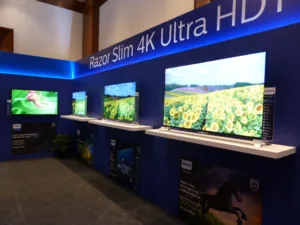Funai is the licensee for Philips’ TV brand in the USA, and is responsible for showing the company’s new TVs every CES, as well as its own products.
Two sets were being shown under the Funai brand: a 98″ UltraHD model, with HDR, and several ultra-slim (5.9mm) LCD sets called ‘Tapestry TV’. There was little information about these models, other than their brightness (500 cd/m² on the 98″ and 450 cd/m² on the Tapestry) and BT.709 gamut coverage (100% and 83%, respectively).
The 8600 series will be Philips’ flagship this year. Available in 55″ and 65″ sizes, the TVs will feature Dolby Vision and HDR10, as well as a new backlight ( we were told red and blue phosphors and a cyan LED, but we think this was wrong! – Man. Ed.), to cover 82% of BT.2020. 120Hz VA panels are used in the sets, and they will be the only new models to use Philips’ 240Hz Perfect Motion Rate motion-smoothing technology.
Resolution will be UltraHD. As with other UltraHD TVs from Philips, the sets will have 802.11ac WiFi with MIMO antennas, as well as RJ45 connectivity and several built-in apps for content streaming. Four HDMI 2.0 ports will also be featured. They will support both HEVC and VP9. Brightness is 550 – 600 cd/m². The sets have 30 micro dimming zones and Ambilux technology (Philips’ High-Concept Ambilight Becomes Reality). They will be launched in August (although press materials say July), for $1,200 (55″) and $1,700 (65″).
Like the 8600 TVs, a new Blu-ray player (BDP7501) will support HEVC and VP9. It will be capable of playing HDR content on SDR sets, play 10-bit colour and feature a 100Mbps peak bit-rate. Philips will launch the player in April, for ‘less than $400’.
The step-down TVs are the 7000 series (49″, 55″ and 65″). These sets, launching between May and June, are UltraHD models with 120Hz PMR, 450 cd/m² brightness and HDR10 support. The TVs will have the same connectivity options as the 8600 models. They will support wireless screencasting and DLNA. Funai revealed prices for two of the TVs, the 49″ ($850) and 55″ ($1,000). These models will be released in July.
The final UltraHD TVs will be the 6000 series. These TVs (49″, 55″ and 65″. 75″ and 85″ models were also showcased but not mentioned in press materials) are designed as an affordable option. They will not have PMR or micro dimming, for instance, but will have the same connectivity and codec support.
The 49″ and 55″ sets use IPS panels and Micro Dimming Pro, while the 65″ is VA with Macro Dimming and HDR support. All three models support DLNA, HEVC and VP9. They will cost $750 (49″), $900 (55″) and $1,400 (65″), and will be released between June and July.
Funai was also showing the 4000 series, a range of 1920 x 1080 sets. A transition from the current range to these new models is already on-going, and should be finished by May. The TVs will come in 32″, 40″, 43″, 50″ and 55″ sizes. They will cost $250, $350, $400, $500 and $650, respectively, and be launched in May.
Finally we looked at Funai’s ‘basic’ TVs under the Magnavox brand. These are all low-end models that lack certain features from the Philips sets. There will be two ‘Netflix Recommended’ UltraHD units (50″ and 55″), called the Y Series. They will cost $500 or $800. The X Series (smart) and V Series (basic) will be 1920 x 1080 sets, in 32″ – 55″ and 24″ – 55″ sizes, respectively.
Analyst Comment
Somewhat surprisingly, there was no news about the 8900 TV from IFA, which was the first to be announced with Ambilux. (TA)

